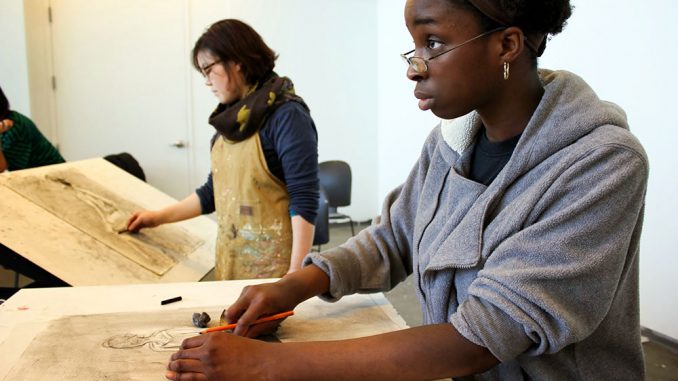
Jennifer Hermann sits still for almost two hours. Her shoulders gently rise and fall and her eyelashes flutter every so often. She looks peaceful as she poses, completely naked, in the middle of 15 students.
For budding artists in the Tyler School of Art, figure drawing means just another day of class and just another naked body.
“[Figure drawing] is just something that’s really traditionally fine arts,” Andrew Ruffin, a senior painting major, said. “It’s really old practice. That’s the way I always thought about it anyway. It’s a classic thing.”
As Ruffin said, figure drawing is ancient and simple – it’s the method of drawing a live nude model to better understand the physique of the human body. This practice has been implemented in art schools for centuries.
Tyler professor and artist Keith Morrison said thousands of students take figure drawing courses across the U.S. every year.
Morrison specializes in drawing and painting and teaches a figure drawing class on Tuesdays and Thursdays on Main Campus.
Though he said some students new to the concept may show discomfort at the thought of studying a naked body professionally, Morrison said he believes it’s necessary for any artist who wants to depict the body in their work.
“The nude model allows you to understand better the figure upon which clothes hang,” Morrison said.
Hermann, who recently modeled for Morrison’s figure drawing class, recalled being nervous the first time she modeled nude – but not for the reasons one might think.
“I just wanted to do what they wanted me to do correctly,” Hermann said. “It’s more about, ‘Am I doing a good pose? Will this be a good drawing for everyone in the room?’”
Hermann said she first encountered the job opportunity through a painter’s advertisement on Craigslist. She drove to his house in Wilmington, Del., and modeled in his home studio.
“He passed my name on to different painters, and that’s how I kept getting more jobs,” she said. “It’s by word of mouth.”
Hermann attended Millersville University 15 years ago, where she earned a master of fine arts degree.
“I was drawing myself and we had models there, and that’s when I realized it’s something people do,” she said.
A metal smith by trade, Hermann specializes in fine jewelry like engagement rings and wedding bands and works at Bario-Neal, a store that sells handcrafted jewelry in the city. She said she models on her days off from work to bolster her income.
Hermann said one of the most difficult aspects of modeling is posing for extended periods of time, which is something she’s learned to do well.
“It’s almost like meditation, you kind of just zone out,” she said.
Hermann said she isn’t self-conscious when it comes to modeling. She said she believes security is an important requirement of the job.
“You have 20 eyes at a time looking at you,” Hermann said. “If you’re worried about every hair or cellulite, those aren’t the things to be worried about.”
Some students said they don’t see flaws during figure drawing, just different qualities to draw.
“Every person is incredibly different,” senior sculpture major Casey Poehlein said. “[Instructors] teach you specific proportions, like there’s seven and a half heads per each body, but that’s not always true.”
Morrison said figure drawing teaches artists how to differentiate between these perceived qualities and actual qualities.
“In drawing the figure, [students] aren’t so much learning how to draw – they’re learning how to see,” Morrison said. “Most of us walk around with a stock of images in our subconscious. There is a discipline between learning what you actually see and what is in your memory.”
Poehlein said he believes this is why a nude model is optimal for figure drawing.
“I think if anyone were to be in this room, they’d understand it’s not really anything scandalous,” Poehlein said.
“You just go in with a business mindset,” Ruffin said. “Drawing is about form and space and composition. I think [figure drawing] really sharpens your skills. You’re training your eye in a sense to see things and be able to interpret relationships aesthetically.”

Figure drawing can benefit the model as well, Hermann said. It’s been a positive experience for her.
“It’s fun,” Hermann said. “I meet a lot of different people, and I can see myself drawn and how people view me.”
Hermann said she believes people should be more comfortable with the human body.
“In Europe it’s no big deal,” Hermann said. “They’ve been doing classical drawing and painting for a lot longer than people in the U.S. have.”
While models like Hermann pose for students, Morrison circles the classroom pointing out various ways students can improve their work.
“People learn to draw the figure like people learn to play the piano,” Morrison said. “You begin with imagination, then you go and refine it.”
Claire Sasko can be reached at claire.sasko@temple.edu.



Be the first to comment